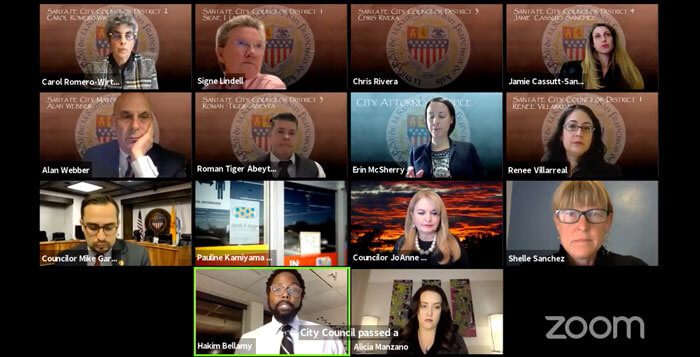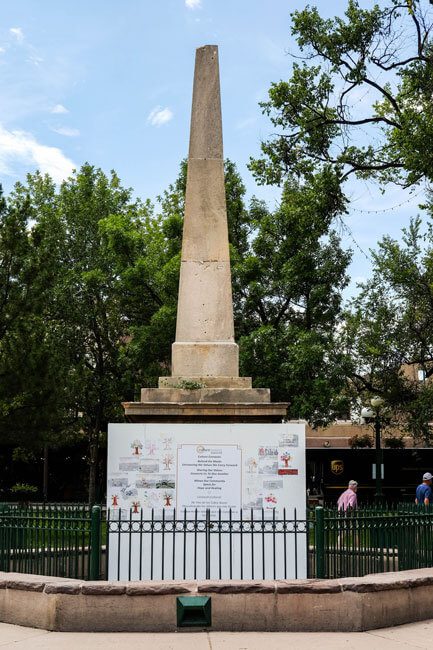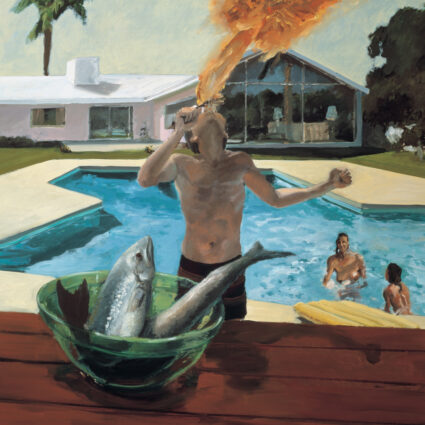The goal of Santa Fe’s Culture, History, Arts, Reconciliation, and Truth (CHART) resolution is bigger than determining the fate of the plaza obelisk.

After months of consideration, Santa Fe’s substitute Culture, History, Arts, Reconciliation and Truth (CHART) resolution was unanimously approved on January 13, 2021. The original iteration of CHART appealed for the creation of a committee to determine the fate of controversial public monuments such as the plaza obelisk. (The obelisk, a monument to soldiers who fought against “savage” Indians in the 19th century, has been the subject of debate for decades, the intensity of which came to a head in June 2020.) Instead, the resolution now calls for a community-centered process of dialogue and healing.
The CHART process is modeled after Albuquerque’s Race, History & Healing Project, which was launched last summer in response to the demonstrations surrounding the Juan de Oñate statue, which is part of the La Jornada (1998, installed in 2005) art installation at the Albuquerque Museum. Oñate was a Spanish conquistador who was responsible for the murder of hundreds of Indigenous people.
“We all agreed that a community-centered process open to everyone was the best way to move forward in deciding what we need to be doing to heal and to address the issues of race and culture that have occurred because of the national conversation, and of course with the events that happened with the obelisk on the plaza,” said City Councilor Carol Romero-Wirth, one of the sponsors of the proposal.

Much like Albuquerque’s process, CHART will consist of three community dialogue sessions, as well as surveys, interviews, and artistic expressions open to the public. People who have participated in all three dialogue sessions will be invited to convene and make their recommendations to the governing body regarding the future of specific monuments as well as a broader approach to historic representation.
“It’s not a fact-finding mission. This is heart work, and it takes time,”
“It’s bigger than ‘should we put the obelisk back up, or should we take it down?’” said Romero-Wirth. “The goal here is to contextualize our collective history and to build broader understanding.”
Michelle Otero, the lead facilitator for Albuquerque’s Race, History & Healing Project, echoed Romero-Wirth’s sentiments. “There’s such a tendency,” she said, “to set the record straight or get to ‘the truth.’ But what actually heals us is acknowledgment of harm. The ability to sit in a circle, stand in my power, speak my truth without causing harm to myself or others, and witness the truth of others.”
The process in Albuquerque, which has concluded, led to a recommendation that the La Jornada installation be reimagined without the Oñate figure with the input of original artist Sonny Rivera, as well as artist Nora Naranjo Morse, who created an installation in response called Numbe Whageh (2005). The recommendation was sent to the city Arts Board, which approved and passed it along to the city council, which acknowledged receipt and elected to wait until they could convene in person to make a determination.
Though they are now in a holding pattern as they wait for the city council’s response, the team in Albuquerque was able to achieve a lot in a short period of time. One of the things we were fortunate to benefit from was swift action,” said Hakim Bellamy, deputy director for Albuquerque’s cultural services department. Within weeks of the first demonstrations at the La Jornada installation, the Race, History & Healing process had begun. They were able to harness the momentum and energy of that moment, and though the pandemic made things slightly more complicated, it also had its benefits. “Transformation is possible via Zoom,” Otero said. “I wouldn’t have thought that before the pandemic. It was more important to do it when we did than to wait till we could all be together in person.”
A lot has happened in the world since June, and Santa Fe may struggle to harness the energy that Albuquerque was able to. But citizens are increasingly energized about these issues and the city is hopeful that the CHART process will draw a wide range of participants. Santa Fe is following Albuquerque’s footsteps in appointing conveners—community members who volunteer to invite their network into the conversation. “That quickly expands your circles,” said Shelle Sanchez, director of Albuquerque’s cultural services department. “We reached out to some people to be conveners knowing that they were on very different sides of the issues.”
While the CHART resolution was incited by the events surrounding the obelisk, and one intention is to make a decision regarding the obelisk’s future, there is a larger, more ambitious objective at hand. The real goal of this process—not to pick a winner or loser, but to encourage a community conversation and create consensus around how we discuss and depict our cultural history—is not something that is going to happen overnight, or probably even in the year that the CHART resolution plans for. Beginning that conversation by building relationships and cultivating mutual understanding is time-consuming, but hopefully, it also creates long-term solutions and strengthens the community as a whole. “It’s not a fact-finding mission. This is heart work, and it takes time,” said Otero. “You work on it steadily, steadily. It’s going to feel at times like it’s water dripping. But if water drips long enough it eventually can crack rocks open and form rivers, and that’s what this work is. It’s about having a sense of patient urgency, or urgent patience.”



